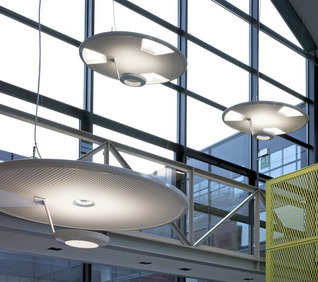
After two years of research Diego Rossi and Raffaele Tedesco, created the Zeno light for Luceplan, which works by transporting light from outside via lightpipes. Optical conduits collect exterior light and convey in a “direct and controlled way” to the fittings. What makes this light different from other lightpipes is that it can also integrate other light sources into the design, like compact fluorescent bulbs, HID Metal-Halide and halogen lamps. This allows for an interfacing of “efficiencies, temperatures, colours and chromatic yields.” The team are looking at technologies which will make it “possible to distribute direct light from the sun and subdivide the cost of the system amongst the tenants of an apartment block.”
Zeno is a suspended ceiling lighting system that optimizes consumption through the intelligent use of both solar and artificial light. The solar light is conducted along fiber optics inside the lamp. It contains two sources of artificial light, direct and fluorescent and the other one indirect and halogen. When the sky gets overcast or it gets darker, the natural light is integrated by the artificial light. Saving 30.000 lumen
Aside from the Zeno, Luceplan have embraced “environmental compatibility” for their operations as a whole (investigating materials choice, manufacturing processes, finishes, design-for-disassembly, packaging, and so on.)

Comments by our Users
Be the first to write a comment for this item.